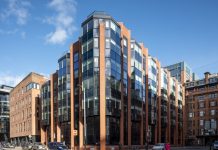After the strong take-up recorded in Q4 last year, it would have been reasonable to expect a weak first quarter for occupier demand in Central London. Yet take-up has come in exactly at the long-term average – 3.10m sq ft. This cannot be dismissed as a few big deals inflating the figures. Deals of over 100,000 sq ft accounted for 17.5% of take-up, which is line with activity in the last ten years, as shown in the latest Knight Frank Central London Quarterly report.
As in the previous quarter, the better- than-expected performance owes much to the on-going change in the composition of demand. In Q1, the Tech and Creative sector took over 700,000 sq ft of office space, towering over the finance sector at around 270,000 sq ft.
Take-up for Tech and Creative firms is running nearly 12% above long-term average, but this is perhaps generating a false impression of demand overall. By holding up so well, tech is disguising the clear weakening of finance activity. Meanwhile, Professional take-up was strong in part because some firms are consolidating and moving support jobs out of London.
Consequently, on demand we have a neutral situation. Some banks and lawyers reduce their London footprint (but do not leave entirely), then growth from the techs balances the books by absorbing the surplus space. The net result is average take-up, which is better than most would have expected nine months ago, but hardly the high-growth London we were so proud of back in 2015. So what might take demand above the average level in the future?
The answer relates to what I call Digital Ubiquity. I see this increasingly shaping office demand, as non-tech firms bring themselves in line with technology trends whose impact vastly overshadows the transitory phenomenon of Brexit.
At a time when there is concern over the outlook for the banking industry, we have the paradox of banks looking for new space to house their digital businesses. Some law firms are freeing up office space to start their own tech incubators and accelerators. Older tech firms are relocating from cheap out-of-town offices to trendy and more expensive central London districts, to be near the new wave in the digital revolution.
The tech and creative ethos and work practice is colonising the rest of the business world, as many firms are hurrying to adapt to the sudden and unexpected arrival of digital start-up competitors in their industries. Adaptation requires investment in reshaping the work environment, as people are the bedrock of an innovation economy, and a new office format can energise idea-sharing and communication.
This march to Digital Ubiquity was tentatively emerging trend in 2015, then it hit a road bump in 2016 with Brexit, which put a lot of business investment on hold temporarily. However, there are signs that Brexit is not going to be as disruptive as previously feared. The government is hinting at a transition deal, whereby EU rules will stay in place and free movement of labour continues beyond March 2019. In other words, we are heading for a compromise.
As this becomes more evident, the brakes on investment in the business world will be removed, and more non-tech firms will turn their attention back to transitioning to Digital Ubiquity. Most firms in the future, irrespective of industry, will operate the tech way, with knock-on implications for office demand.
In January there was widespread concern that banks would leave London en-masse, then in February the German Finance Minister told a conference “the financial centre of London will remain and be important to the EU economy as a whole”.
James Roberts, Chief Economist at Knight Frank said: “Brexit is receding as a threat to the outlook, and with employment levels currently at a record high, the pre-referendum trends in the London office market are resurfacing.”
Stephen Clifton, Head of Central London at Knight Frank said: “The weight of money chasing Central London assets continues to weigh on pricing, and prime yields in both the City and the West End at 4.25% and 3.50% respectively, show little sign of softening with the possibility of yield compression in the City. We expect turnover to increase as the year progresses as more stock is released to the market”.



















